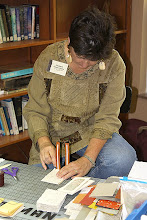Recently, Jacqueline Klene, with Art St. Louis, interviewed me about my art juried into the [context] TEXTURE show opening Saturday, August 11, 6-8pm at Art St. Louis, as well as my thoughts on being an artist. You can read the edited responses and see the artwork of the four artists interviewed on the August 7th post of the
Art St. Louis Blog.
Below is my full response to Jacqueline's questions:
1. How do you feel that your work relates to the
theme and exhibit of "[context] Texture"?
My work, Sun Pans and Mica Drags, was constructed
with embossed, dyed, pigmented, painted and stitched handmade papers that I
made from various plant fibers. Cornwall,
UK, the land of my husband’s birth, has a mining history dating back more than
3000 years. Women, known as Bal Maidens, worked primarily above
ground; but during the World Wars, they were often assigned mining duties
previously reserved for men. My intent in Sun Pans and Mica
Drags was to capture the essence and remnants of the 19th century china clay mines as seen still today from the air, through the earth and
across the moors.
2. What subjects and/or artistic movements
influence you the most?
Having been an illustrator, art educator, and an avid
gardener for many years, I have always been drawn to aerial views of land,
maps, rivers, soil, and organic systems. Experimenting with handmade plant
fiber paper is a culmination of that attraction to texture and natural
materials. By combining my papers with ephemera collected along the way, my
work layers history, meaning, and place into objects that are no longer lost or
misplaced, but reconstructed and transformed.
3. Do you find that your work is easy to relate to?
While
the history, meaning and place represented by this body of work is significant
to me, the viewer who is drawn to the work will bring their own aesthetic
preferences and layers of meaning to the work. Their perceptions, connected to their own
memories, are equally valid.
4. What do you strive for as an artist?
For
more than 25 years, I was an illustrator. Every piece of artwork was a literal
representation of a person, place or event that had to be easily “read” by the
art director, the editor and the intended audience. The medium, colors,
subjects, and styles of illustration were selected by the client, not me. Thus,
I eventually burnt out. Now, I no longer take commissions. My work is driven by
natural materials connected to place, making and meaning with focus on
craftsmanship.
5. What is your process?
During
the summers, when I am not teaching, my husband and I travel back to Cornwall.
His family nurtures us as we wander through working fishing villages and along
cliff top paths; down narrow hedgerows onto pebbled beaches and tidal pools;
through disused mines and pre-Christian churches; and finally across the moors
filled with wild ponies and herds of sheep. Every step is filled with layers of
ancient history, place, people, texture, industry, work, survival, beauty and
faith. My process is to read, record,
draw, paint, listen, smell, taste, collect memories, and stash bits of ephemera
to the point of exhaustion. Back in my garden/studio in Illinois, I distill,
clarify and make the handmade paper used in my constructions. The textures and
colors are a collection of memories, the essence of Cornwall’s natural beauty
and industrial history, non-specific to an exact mine or village. As the constructions
are developed, the materials inform and challenge the process of simultaneously
layering and abstracting multiple vantage points within the landscapes.

6. When did you decide to become an artist?
As
a child, I lived with my father’s parents. They taught the next generations how
to make what was used and what was needed. Craftsmanship was important whether
we were making a dress on a treadle sewing machine, planting the vegetable
garden, or building a cabinet. They didn’t realize they were artists. They just “made do.” In 1974, I decided to go
to St. Louis Community College at Florissant Valley to become a commercial
artist after my second knee surgery for rheumatoid arthritis in high school
squelched my plans to become a physical therapist. My grandma didn’t think
commercial art was “real art,” but I could make a living. When I was offered a
job by an advertising agency before I finished my degree, grandma thought I
should have stayed in school to finish the Associate Degree. Twenty years
later, after working as a successful illustrator for publishers all across the
country, she still thought I should finish my degree; and that I still wasn’t a
real artist. Funny how things stick in
the back of your mind. When I returned to school in 2002 to earn a teaching
degree, I thought of her. And now that I have a BA in K-12 Art Education, a BFA
in Art & Design, a MSEd in Secondary Education/Art, and a MA in K-12
Education with an Emphasis in Character Education, with artwork in public and private
collections in the United States and England, I still hear her voice in my head
and wonder if I have done enough, or would ever do enough, to be a “real
artist.”
I
am an artist, a teacher, a wife, a mother, a friend, and a woman of faith. Looking back on the past 56 years of life
through the knowledge and understanding of an art educator, I realize that I
have always been an artist. I have
always been creative. I have always thought of multiple ways of solving
problems. I have always asked, why? It just took 36 years in the field, four
degrees, and the faith in oneself that comes with hard work … and age … for me
to come to accept, and be proud, of who I am – A R T I S T.






























